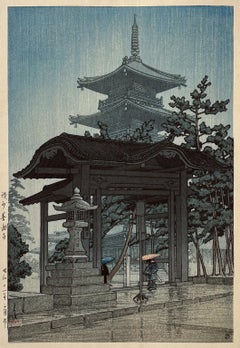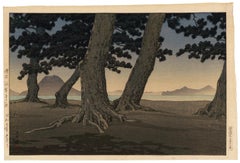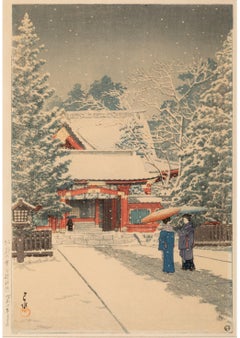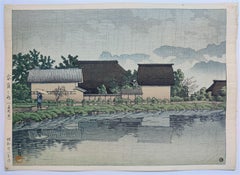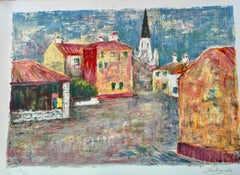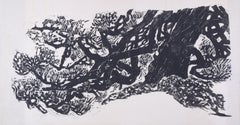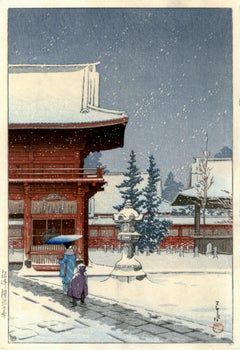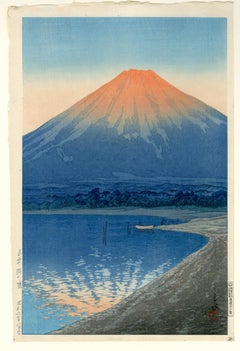Kawase Hasui Landscape Prints
Japanese, 1883-1957
Hasui Kawase (Japanese, 1883 -1957) was an artist, one of modern Japan's most important and prolific printmakers. He was a prominent designer of the shin-hanga ("new prints") movement, whose artists depicted traditional subjects with a style influenced by Western art. Like many earlier ukiyo-e prints, Hasui's works were commonly landscapes, but displayed atmospheric effects and natural lighting.
Hasui designed approximately 620 prints over a career that spanned nearly forty years. Towards the end of his life the government recognized him as a Living National Treasure for his contribution to Japanese culture.
From youth Hasui dreamed of an art career. His maternal uncle was Kanagaki Robun (1829–94), a Japanese author and journalist, who produced the first manga magazine. Hasui went to the school of the painter Aoyagi Bokusen as a young man. He sketched from nature, copied the masters' woodblock prints, and studied brush painting with Araki Kanyu. His parents had him take on the family rope and thread wholesaling business, but its bankruptcy when he was 26 freed him to pursue art.
He approached Kiyokata Kaburagi to teach him, but Kaburagi instead encouraged him to study Western-style painting, which he did with Okada Saburōsuke for two years. Two years later he again applied as a student to Kaburagi, who this time accepted him. Kiyokata bestowed the name Hasui upon him, which can be translated as "water gushing from a spring", and derives from his elementary school combined with an ideogram of his family name.
Kawase studied ukiyo-e and Japanese style painting at the studio of Kiyokata Kaburagi. He mainly concentrated on making watercolors of actors, everyday life and landscapes, many of them published as illustrations in books and magazines in the last few years of the Meiji period and early Taishō period.
Kawase worked almost exclusively on landscape and townscape prints based on sketches and watercolors he made in Tokyo and during travels around Japan. However, his prints are not merely meishō (famous places) prints that are typical of earlier ukiyo-e masters such as Hiroshige and Katsushika Hokusai (1760-1849). Kawase's prints feature locales that are tranquil and obscure in urbanizing Japan.
Hasui Kawase's works are currently kept in several museums worldwide, including the British Museum, the Toledo Museum of Art, the Brooklyn Museum, the Indianapolis Museum of Art, the Museum of Fine Arts, Boston, the Metropolitan Museum of Art, the Portland Art Museum, the Los Angeles County Museum of Art, the University of Michigan Museum of Art, the Minneapolis Institute of Art, the Stanley Museum of Art, the Walters Art Museum, the Clark Art Institute, the Smart Museum of Art, the Nelson-Atkins Museum of Art, and the Virginia Museum of Fine Arts.to
2
4
Overall Width
to
Overall Height
to
9
184
169
146
131
4
2
2
2
2
3
3
2
2
2
1
1
1
1
1
1
1
1
1
1
1
1
1
1
1
4
1
2
Artist: Kawase Hasui
Zentsuji Temple in the Rain — from the series Collected Views of Japan II
By Kawase Hasui
Located in Myrtle Beach, SC
Kawase Hasui, 'Zentsuji Temple in the Rain' from the seres 'Collected Views of Japan II', color woodblock print, 1937. Signed Hasui in black ink, with the artist’s red seal Kawase, ...
Category
1930s Showa Kawase Hasui Landscape Prints
Materials
Woodcut
'The Beach at Kaiganji in Sanuki Province' — Lifetime Impression
By Kawase Hasui
Located in Myrtle Beach, SC
Kawase Hasui, 'The Beach at Kaiganji in Sanuki Province (Sanuki Kaiganji no hama),' from the series Collected Views of Japan II, Kansai Edition (Nihon fûkei shû II Kansai hen), woodblock print, 1934. A very fine, atmospheric impression, with fresh colors; the full sheet, in excellent condition. Signed 'Hasui' with the artist’s seal 'Kawase', lower left. Published by Watanabe Shozaburo with the Watanabe ‘D’ seal indicating an early impression printed between 1931 - 1941. Stamped faintly 'Made in Japan' in the bottom center margin, verso.
Horizontal ôban; image size 9 3/8 x 14 1/4 inches (238 x 362 mm); sheet size approximately 10 5/16 x 15 1/2 inches ( 262 x 394 mm).
Collections: Art Institute of Chicago; Austrian Museum of Applied Arts (Vienna); Honolulu Museum of Art; Museum of Fine Arts, Boston; National Museum in Warsaw; University of Wisconsin-Madison.
ABOUT THE ARTIST
“I do not paint subjective impressions. My work is based on reality...I can not falsify...(but) I can simplify…I make mental impressions of the light and color at the time of sketching. While coloring the sketch, I am already imagining the effects in a woodblock print.” — Kawase Hasui
Hasui Kawase...
Category
1930s Showa Kawase Hasui Landscape Prints
Materials
Woodcut
Kawase Hasui -- Snow at Hie Shrine, circa 1946 - 1957
By Kawase Hasui
Located in BRUCE, ACT
Kawase Hasui (Japanese, 1883-1957)
Snow at Hie Shrine, circa 1946 -1957 (dated in the publisher's seal)
Woodblock
Sheet size 37.5 x 26.0 cm (vertical oban)
Frame size 51.3 x 38.5 x 2...
Category
1940s Kawase Hasui Landscape Prints
Materials
Woodcut
$4,823 Sale Price
30% Off
Kawase Hasui -- Rain at Yasuniwa (Nagano)
By Kawase Hasui
Located in BRUCE, ACT
Kawase Hasui
Rain at Yasuniwa (Nagano), 1946
woodcut in colours
Signed on the block, sealed, titled and dated in ink
Publisher: Shozaburo Watanabe, with his 6mm seal
The first state
...
Category
1940s Kawase Hasui Landscape Prints
Materials
Woodcut
$3,168 Sale Price
20% Off
Related Items
Village of Montmarte, Paris
By Shungo Sekiguchi
Located in Belgrade, MT
This piece is part of my private collection since the 1970's. It is an original color lithograph signed and numbered by the Japanese artist Shungo Sekiguchi. In 1935 Shungo Sekiguchi...
Category
Mid-20th Century Modern Kawase Hasui Landscape Prints
Materials
Lithograph, Woodcut
Matsu (Pine)
Located in Fairlawn, OH
Matsu (Pine)
Woodcut, 1968
Signed: "'Matsu' Naoko Matsubara" in pencil by the artist (see photo)
Annotated in pencil "Ed 25" (see photo)
Edition: 25
Condition: 7" long waterstain at ...
Category
1960s Abstract Kawase Hasui Landscape Prints
Materials
Woodcut
Jacob Heller “Tropical Mexico”
Located in San Francisco, CA
Fabulous cubist wood cut of a Mexican village. It is titled tropical Mexico and is by the artist Jacob Heller. Really kool sky with lines for rain and ovals for clouds.There is not m...
Category
Mid-20th Century Cubist Kawase Hasui Landscape Prints
Materials
Woodcut
Maison Typique Doorways
Located in Houston, TX
Delightful French woodcut titled "Maison Typique", 1981. Signed and dated lower right. 66/200
Original artwork on paper displayed on a white mat with...
Category
1980s Kawase Hasui Landscape Prints
Materials
Woodcut
Four trees. Paper, wood carving , 29x29 cm
Located in Riga, LV
Four trees. Paper, wood carving, 29x29 cm
Dzidra Ezergaile (1926-2013)
Born in Riga. School years alternate with summer work in the countryside. In 1...
Category
1970s Abstract Kawase Hasui Landscape Prints
Materials
Paper, Woodcut
$405 Sale Price
20% Off
H 11.42 in W 11.42 in D 0.04 in
Clinton Hill, Title Page II, 1956, woodcut, landscape/abstraction
By Clinton Hill
Located in New York, NY
Clinton Hill (1922-2003), lived in SoHo, New York, and was a frequent Gallery visitor. Born in Idaho and raised on a working ranch, he joined the US Navy during World War II and beca...
Category
Mid-20th Century Abstract Kawase Hasui Landscape Prints
Materials
Woodcut
$1,500
H 20 in W 17.75 in
Fleet Street, London
By Luigi Kasimir
Located in Fairlawn, OH
Fleet Street, London
Soft ground etching & aquatint, c. 1936
Signed in pencil by the artist (see photo)
Condition: Very good condition with brown paper tape along the edges of the la...
Category
1930s Kawase Hasui Landscape Prints
Materials
Etching, Woodcut
Clinton Hill, Arroyo, 1962, woodcut, landscape/abstraction
By Clinton Hill
Located in New York, NY
Clinton Hill (1922-2003), lived in SoHo, New York, and was a frequent Gallery visitor. Born in Idaho and raised on a working ranch, he joined the US Navy during World War II and beca...
Category
Mid-20th Century Abstract Kawase Hasui Landscape Prints
Materials
Woodcut
$1,500
H 16.63 in W 3.25 in
Trees
By Nicolas Party
Located in London, GB
Woodcut on BFK Rives paper, produced in 2020. Edition of 100. Mint condition, unframed. Signed and numbered in pencil by Nicolas Party.
Category
2010s Contemporary Kawase Hasui Landscape Prints
Materials
Woodcut
Clinton Hill, (Vertical Landscape), 1960, woodcut, landscape/abstraction
By Clinton Hill
Located in New York, NY
Clinton Hill (1922-2003), lived in SoHo, New York, and was a frequent Gallery visitor. Born in Idaho and raised on a working ranch, he joined the US Navy during World War II and beca...
Category
Mid-20th Century Abstract Kawase Hasui Landscape Prints
Materials
Woodcut
$1,200
H 25.25 in W 8.25 in
Bougival
By Maurice de Vlaminck
Located in Fairlawn, OH
Bougival
Woodcut, 1914
Signed and numbered in pencil
Edition 30, this numberd 22
Printed on laid Van Gelder Zonen paper
Published by Henri Kanweiler, Paris
Printed by Paul Birault, P...
Category
1910s Fauvist Kawase Hasui Landscape Prints
Materials
Woodcut
Walter DuBois Richards, The Lobster Float
By Walter DuBois Richards
Located in New York, NY
Ohio-born Walter DuBois Richards (1907-2006) was educated at the Cleveland School of Art. He re-located to New York around 1933 where he had a successful career as a commercial artis...
Category
1930s American Modern Kawase Hasui Landscape Prints
Materials
Woodcut
Previously Available Items
Snow at Nezu-Gongen Shrine (Nezu-Gongen no yuki)
By Kawase Hasui
Located in Fairlawn, OH
Snow at Nezu-Gongen Shrine
(Nezu-Gongen no yuki)
Color woodcut, 1933
Signed in the block Hasui with the red Kawase seal
(see photo)
Publisher: Watanabe, with the "J" seal, de...
Category
1930s Modern Kawase Hasui Landscape Prints
Materials
Woodcut
Daybreak over Lake Yamanaka
By Kawase Hasui
Located in Fairlawn, OH
Daybreak over Lake Yamanaka
Color woodcut, 1931
Published by the Watanabe Color Print Co.
Watanabe seal "D" (1931-1941) See photo
Pre-war design and pre-war printing
Lake Yamanaka i...
Category
1930s Kawase Hasui Landscape Prints
Materials
Woodcut
Kawase Hasui -- Taisho Pond Kamikochi 土高橋大正池
By Kawase Hasui
Located in BRUCE, ACT
Kawase Hasui 川瀬 巴水 (1883-1957)
Title: Taisho Pond Kamikochi 土高橋大正池
Date: Ca. 1927
First state
Oban
frame size: 49.8 x 37.5 x 2 cm
The red “Rumi” seal of the publisher in the lower r...
Category
1920s Kawase Hasui Landscape Prints
Materials
Woodcut
Mount Fuji, Narusawa (Late Autumn) — Lifetime Impression
By Kawase Hasui
Located in Myrtle Beach, SC
Kawase Hasui, 'Mount Fuji, Narusawa (Late Autumn)', color woodblock print, 1936. A fine impression, with fresh colors; on cream wove Japan paper, the full sheet with margins, in excellent condition. Signed 'Hasui' in black ink with the artist’s red seal 'Kawase', lower right. The 6mm circular seal of publisher Watanabe (used 1946-1957), lower left, indicating a lifetime impression. Archivally sleeved, unmatted.
Impressions of this work are held in the collections of the Art Institute of Chicago; The National Museum of Modern Art, Tokyo; and the Museum of Fine Arts Boston.
ABOUT THE IMAGE
The village of Narusawa is located in Japan’s Fuji-Hakone-Izu National Park, which was established in the same year Kawase Hasui’s “Mt. Fuji, Narusawa” image was printed. The park partially encompasses the foothills of Mt Fuji, seen here as the backdrop to a family farm as a mother and daughter perform their daily chores. A drift of late autumn clouds passes...
Category
1930s Showa Kawase Hasui Landscape Prints
Materials
Woodcut
Kiyomizu Temple in the Snow - Woodblock Print
By Kawase Hasui
Located in Soquel, CA
Kiyomizu Temple in the Snow - Woodblock Print
A spectacular woodblock print by Hasui Kawase (Japanese, 1883-1957), depicting a serene wintery balcony with two women under umbrellas in the falling snow at the Kiyomizu Temple (Temple of Pure Waters). One of the most celebrated temples in Japan, the temple was founded in 780 on the site of the Otowa Waterfall among the wooded hills to the east of Kyoto - the temple's name based on the fall's crystalline waters.
Publisher: Doi Hangaten
Artist's seal and signature in lower right corner.
Presented in a new white mat.
Paper size: 15.63"H x 10.25"W (ôban size with raw top edge)
Mat size: 24"H x 20"W
Hasui Kawase (Japanese, 1883 -1957) was an artist, one of modern Japan's most important and prolific printmakers. He was a prominent designer of the shin-hanga ("new prints") movement, whose artists depicted traditional subjects with a style influenced by Western art. Like many earlier ukiyo-e prints, Hasui's works were commonly landscapes, but displayed atmospheric effects and natural lighting.
Hasui designed approximately 620 prints over a career that spanned nearly forty years. Towards the end of his life the government recognized him as a Living National Treasure for his contribution to Japanese culture.
From youth Hasui dreamed of an art career. His maternal uncle was Kanagaki Robun (1829–94), a Japanese author and journalist, who produced the first manga magazine. Hasui went to the school of the painter Aoyagi Bokusen as a young man. He sketched from nature, copied the masters' woodblock prints, and studied brush painting with Araki Kanyu. His parents had him take on the family rope and thread wholesaling business, but its bankruptcy when he was 26 freed him to pursue art.
He approached Kiyokata Kaburagi to teach him, but Kaburagi instead encouraged him to study Western-style painting, which he did with Okada Saburōsuke...
Category
1940s Edo Kawase Hasui Landscape Prints
Materials
Ink, Laid Paper
Spring Evening, Ueno Toshogu Shrine - Woodblock Print with First Edition Seal
By Kawase Hasui
Located in Soquel, CA
Spring Evening, Ueno Toshogu Shrine - Woodblock Print with First Edition Seal
Woodblock print by Hasui Kawase (Japanese, 1883-1957). A crescent moon hangs above the five-story red pagoda of Kan’ei Temple on a clear spring evening in Ueno. Flowering cherry trees create a profusion of pink that adds to the beauty of the view. This 17th century temple is now part of Ueno Park in Tokyo and is an National Important Cultural Property, and one of the few original buildings that survived the Battle of Ueno in 1868.
Publisher: Watanabe Shôzaburô
First edition, with the round Watanabe seal that was in use in the late 1940s, lower left.
Edge notations can be faintly seen through the paper from verso.
Artist's seal and signature in lower right corner.
Presented in an off-white mat.
Paper size: 15.25"H x 10.5"W (ôban size with raw top edge)
Mat size: 18.5"H x 13.25"W
Hasui Kawase (Japanese, 1883 -1957) was an artist, one of modern Japan's most important and prolific printmakers. He was a prominent designer of the shin-hanga ("new prints") movement, whose artists depicted traditional subjects with a style influenced by Western art. Like many earlier ukiyo-e prints, Hasui's works were commonly landscapes, but displayed atmospheric effects and natural lighting.
Hasui designed approximately 620 prints over a career that spanned nearly forty years. Towards the end of his life the government recognized him as a Living National Treasure for his contribution to Japanese culture.
From youth Hasui dreamed of an art career. His maternal uncle was Kanagaki Robun (1829–94), a Japanese author and journalist, who produced the first manga magazine. Hasui went to the school of the painter Aoyagi Bokusen as a young man. He sketched from nature, copied the masters' woodblock prints, and studied brush painting with Araki Kanyu. His parents had him take on the family rope and thread wholesaling business, but its bankruptcy when he was 26 freed him to pursue art.
He approached Kiyokata Kaburagi to teach him, but Kaburagi instead encouraged him to study Western-style painting, which he did with Okada Saburōsuke...
Category
1940s Edo Kawase Hasui Landscape Prints
Materials
Ink, Laid Paper
H 18.5 in W 13.25 in D 0.03 in
Kawase Hasui -- Meguro Fudo Temple 目黑不动堂
By Kawase Hasui
Located in BRUCE, ACT
Title "Meguro Fudo Temple" 目黑不动堂
Date 1931; (c1940's/50's)
Publisher Watanabe Shozaburo
Seal, Carver/Printer red 6mm (lifetime edition)
Image Size 9.5 x 14.4
Impressio...
Category
Early 20th Century Kawase Hasui Landscape Prints
Materials
Woodcut
Moon at Magome
By Kawase Hasui
Located in Burbank, CA
"Moon at Magome," from "Twenty Views of Tokyo". In this masterful evening view, the yellow glow from a small window echoes the haunting presence of the full, yellow moon. This field ...
Category
Early 20th Century Showa Kawase Hasui Landscape Prints
Materials
Handmade Paper, Woodcut
Mount Fuji Seen from Tagonoura, Evening — lifetime impression
By Kawase Hasui
Located in Myrtle Beach, SC
Kawase Hasui, Tagonoura no yuu II (Mount Fuji Seen from Tagonoura, Evening), color woodblock print, 1940. A fine impression, with fresh colors; on cream wove Japan paper, the full sh...
Category
1940s Showa Kawase Hasui Landscape Prints
Materials
Woodcut
Spring Evening at the Kintaikyo Bridge (Kintaikyo no Shunsho)
By Kawase Hasui
Located in Myrtle Beach, SC
A very fine, exceptionally well-inked impression, with fresh, vivid colors, and strong contrasts, from the original publisher’s folder, never matted, framed or exposed to sunlight; i...
Category
Mid-20th Century Showa Kawase Hasui Landscape Prints
Materials
Woodcut
H 14.32 in W 9.44 in D 0.01 in
Shinshu Matsubarako (Lake Matsubara, Shinshu)
By Kawase Hasui
Located in Myrtle Beach, SC
Kawase Hasui, 'Shinshu Matsubarako' (Lake Matsubara, Shinshu), color woodblock print, 1941. Signature ‘Hasui’. Artist's seal (’sui’), lower right. Watanabe's 6 mm round 'A' seal (194...
Category
1940s Showa Kawase Hasui Landscape Prints
Materials
Woodcut
Itsukushima no Yuki (Snow at Itsukushima)
By Kawase Hasui
Located in Myrtle Beach, SC
Kawase Hasui, 'Itsukushima no Yuki' (Snow at Itsukushima), color woodblock print, 1937. Signature ‘Hasui’. Artist's seal (’sui’), lower left. Watanabe, early edition with ‘C” seal (1...
Category
1930s Showa Kawase Hasui Landscape Prints
Materials
Woodcut
Kawase Hasui landscape prints for sale on 1stDibs.
Find a wide variety of authentic Kawase Hasui landscape prints available for sale on 1stDibs. If you’re browsing the collection of landscape prints to introduce a pop of color in a neutral corner of your living room or bedroom, you can find work that includes elements of blue and other colors. You can also browse by medium to find art by Kawase Hasui in woodcut print and more. Not every interior allows for large Kawase Hasui landscape prints, so small editions measuring 9 inches across are available. Kawase Hasui landscape prints prices can differ depending upon medium, time period and other attributes. On 1stDibs, the price for these items starts at $1,280 and tops out at $6,000, while the average work can sell for $3,250.
Questions About Kawase Hasui Landscape Prints
- What did Hasui Kawase do?1 Answer1stDibs ExpertJune 30, 2023Hasui Kawase made woodblock prints and was one of the most important modern Japanese artists. The woodblock printmaking genre, unique to Japan, grew out of 17th-century developments in printing and book publishing. Kawase was a prominent practitioner of the shin-hanga (“new prints”) movement, whose artists depicted traditional subjects with a style influenced by Western art. Like many earlier artists working in woodblock printmaking, Hasui primarily created richly atmospheric landscapes. They’re characterized by an emphasis on natural lighting and the artist’s effort to draw attention to the beauty of nature. Hasui created hundreds of prints over a career that spanned nearly forty years. On 1stDibs, find a range of original Japanese woodblock prints.
- Where was Kawase Hasui born?1 Answer1stDibs ExpertFebruary 17, 2023Kawase Hasui was born in Tokyo, Japan, in 1883. He was one of modern Japan's most important and prolific printmakers and a prominent designer of the shin-hanga ("new prints") movement, whose artists depicted traditional subjects with a style influenced by Western art. Shop a range of Kawase Hasui art from some of the world's top galleries on 1stDibs.
